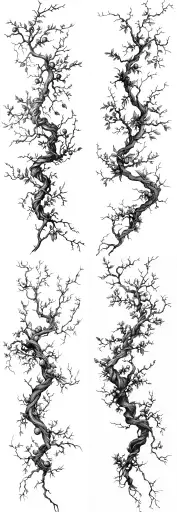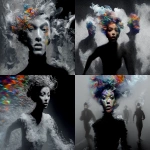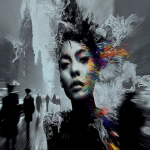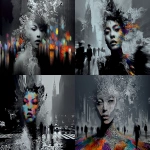Explore the Best AI Image Gallery

Pixels on Skin: How Wearable Tech is Transforming the Creative Canvas
The realm of creativity is undergoing a metamorphosis, fueled by the rise of wearable technology.
No longer confined to traditional mediums like canvas and chisel, artists and designers are now wielding smartwatches, augmented reality glasses, and haptic suits as their tools, blurring the lines between the physical and digital worlds. This fusion of technology and artistry is giving birth to innovative forms of expression, reshaping how we create, interact with art, and perceive the world around us.
A New Dimension of Artistic Expression
Wearable tech empowers artists to transcend the limitations of traditional mediums, offering a plethora of possibilities:
- Interactive Art Installations: Imagine walking through an exhibition where sculptures react to your movements, paintings shift colors based on your proximity, or sound installations respond to your heartbeat. Wearables can transform static artworks into dynamic, immersive experiences that engage viewers on a deeper level.
- Body as Canvas: Artists can use wearable displays to project light, patterns, or even miniature animations onto their bodies, turning themselves into living canvases. This opens up exciting avenues for performance art and body painting, where the artists movements and expressions become integral to the artwork.
- Haptic Feedback in Art: By incorporating haptic technology—the ability to feel sensations through touch—wearables can add a tactile dimension to art. Imagine feeling the texture of a virtual sculpture or experiencing the vibration of a heartbeat within an installation. This multisensory approach enriches the artistic experience and allows viewers to connect with artworks on a more visceral level.
Designing for Wearability
The unique challenges of designing for wearable tech necessitate a shift in perspective:
- User Comfort and Ergonomics: Wearables must be comfortable to wear for extended periods, considering factors such as weight distribution, material choice, and ease of movement. Designers need to prioritize user comfort without compromising functionality or aesthetics.
- Seamless Integration with Technology: Wearable designs should seamlessly integrate with existing technology ecosystems, allowing users to control their devices, access information, and interact with the digital world in a natural way.
- Intuitive User Interfaces: Interactions with wearable tech must be intuitive and user-friendly. Designers need to consider how users will navigate menus, control functions, and access information through touch, voice commands, or gestures.
Ethical Considerations in a Wearable World
The rise of wearable tech also raises important ethical considerations that must be addressed:
- Privacy and Data Security: Wearables collect vast amounts of personal data about users, including their movements, health information, and even emotional states. Its crucial to ensure that this data is protected from unauthorized access and used responsibly.
- Bias in Algorithms: Like all AI-powered technologies, wearable devices can perpetuate existing societal biases if not carefully designed. Designers must strive to create algorithms that are fair, equitable, and inclusive, avoiding discrimination based on factors such as race, gender, or socioeconomic status.
- Accessibility and Inclusivity: Wearable technology should be accessible to all individuals, regardless of their abilities or disabilities. Designers need to consider the needs of users with visual impairments, hearing loss, or mobility limitations.
The Future of Creativity: A Convergence of Technologies
The future of wearable tech in the creative industry is brimming with possibilities. We can expect:
- Enhanced Collaboration: Wearables will facilitate seamless collaboration between artists, designers, and other creatives, allowing them to share ideas, work together on projects in real time, and iterate designs more efficiently.
- Immersive Experiences: Augmented reality (AR) and virtual reality (VR) integrated with wearables will create immersive artistic experiences that transport viewers to new worlds and engage their senses in unprecedented ways.
- Personalized Art: Wearables will enable artists to create personalized artworks tailored to individual preferences, allowing viewers to interact with art on a deeply personal level.
As wearable technology continues to evolve, it will undoubtedly continue to revolutionize the creative landscape. By embracing its potential while addressing ethical considerations, we can usher in a new era of artistic expression that is more inclusive, interactive, and transformative than ever before.
](https://images.ai-img.art/thumbnails/150/7cf5a08238f29c821f52bb4f63db48af0b7f633ff3b9f7253074d78ced9ff6f6.webp)


](https://images.ai-img.art/thumbnails/150/ff09e32d2be011c0dd785984c5c1e47839ce551a31da1bde242860b30df2aa30.webp)
](https://images.ai-img.art/thumbnails/150/847809c77ca9a73b68bc190e6efb06fec87157685a243730d5a66a403b0e6e10.webp)




](https://images.ai-img.art/thumbnails/150/0ba0be922ab76af53f75ab90126ae2b18a600ee3b96941e8ab897a9f10594e5a.webp)









](https://images.ai-img.art/thumbnails/150/a3ed6513a6661aa3ee46e0c2924d1e8888854e91d8908de39db5590dc41f8d8f.webp)



















](https://images.ai-img.art/thumbnails/150/2ebdeb4f7db35100e5be5de9bc3e533a40d14e5feedefd7ffc586524a0f3ba8c.webp)



](https://images.ai-img.art/thumbnails/150/bd056a4718c27444e064198762f8dc8ffa1f74f1afd7dcda8d5cb8b142797d6e.webp)


](https://images.ai-img.art/thumbnails/150/685ae68cfab93a7e59a71206867b060c45bd6fd3cd561c4fe60fca514b09c5f8.webp)


